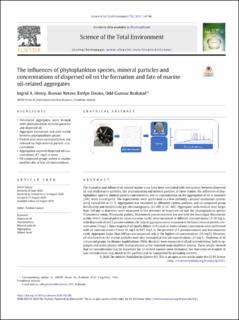| dc.description.abstract | The formation and fallout of oil-related marine snow have been associated with interactions between dispersed oil and small marine particles, like phytoplankton and mineral particles. In these studies, the influences of phytoplankton species, mineral particle concentration, and oil concentration on the aggregation of oil in seawater (SW) were investigated. The experiments were performed in a low-turbidity carousel incubation system, using natural SW at 13 °C. Aggregation was measured by silhouette camera analyses, and oil compound group distribution and depletion by gas chromatography (GC-FID or GC–MS). Aggregates with median sizes larger than 500 μm in diameter were measured in the presence of dispersed oil and the phytoplankton species Thalassiosira rotula, Phaeocystis globosa, Skeletonema pseudocostatum, but not with the microalgae Micromonas pusilla. When mineral particles (diatomaceous earth) were incubated at different concentrations (5–30 mg/L) with dispersed oil and S. pseudocostatum, the largest aggregates were measured at the lower mineral particle concentration (5 mg/L). Since dispersed oil rapidly dilutes in the marine water column, experiments were performed with oil concentrations of from 10 mg/L to 0.01 mg/L in the presence of S. pseudocostatum and diatomaceous earth. Aggregates larger than 500 μm was measured only at the highest oil concentrations (10 mg/L). However, oil attachment to the marine particles were also measured at low oil concentrations (≤1 mg/L). Depletion of oil compound groups (n-alkanes, naphthalenes, PAHs, decalins) were measured at all oil concentrations, both in aggregate and water phases, with biodegradation as the expected main depletion process. These results showed that oil concentration may be important for oil-related marine snow formation, but that even oil droplets at low concentrations may attach to the particles and be transported by prevailing currents. | en_US |

